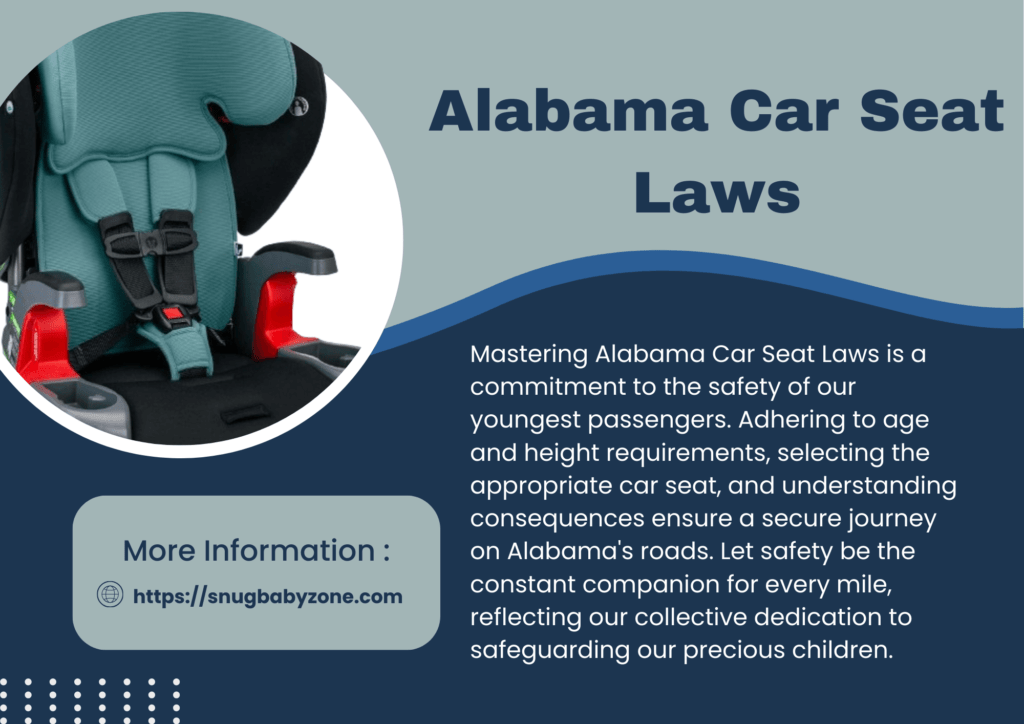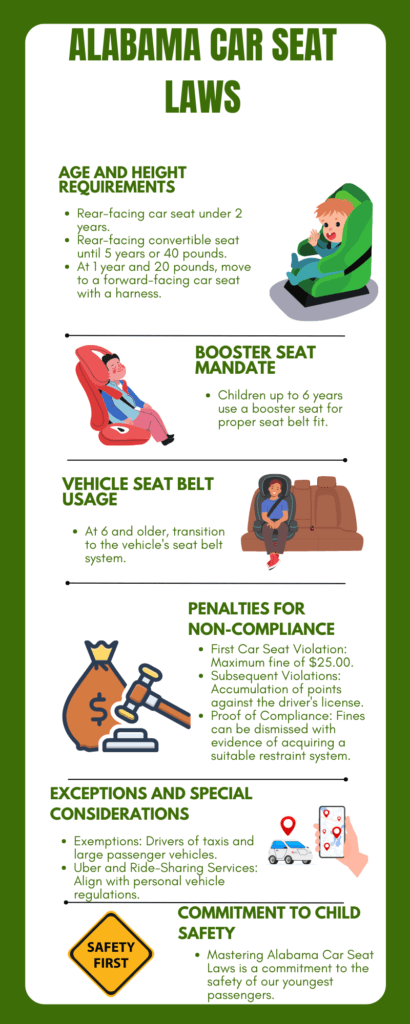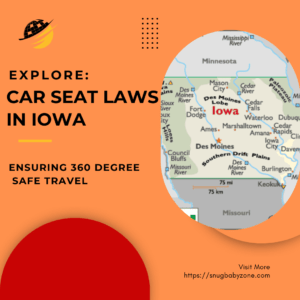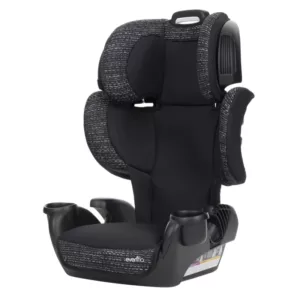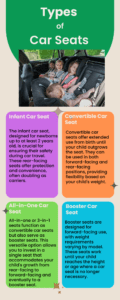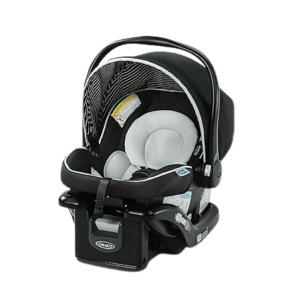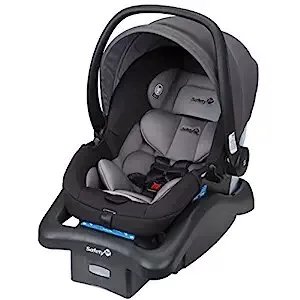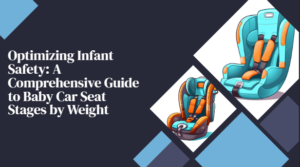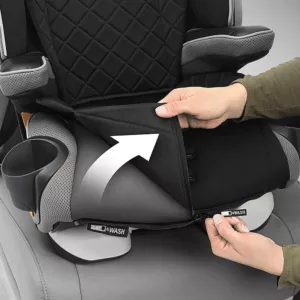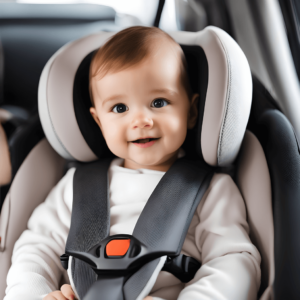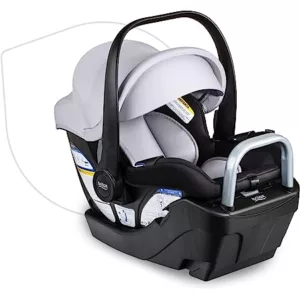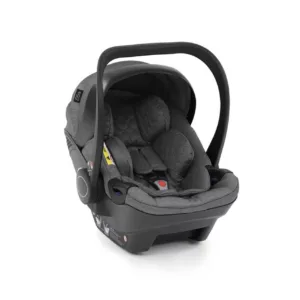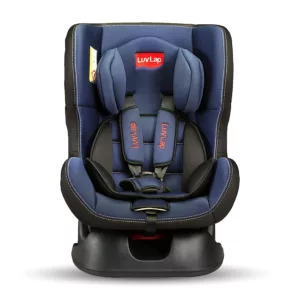We must comprehend and abide by Alabama’s state car seat requirements to protect our children’s safety when driving. This extensive reference covers age and height restrictions, car seat types, and the penalties for breaking Alabama’s car seat laws. Its goal is to give parents and caregivers a clear and concise road map through the state’s car seat laws.
Thank you for reading this post, don't forget to subscribe!Info-Graphics: Alabama Car Seat Laws
Age and Height Requirements: Car Seat Laws Alabama Car Seat Safety Laws
Alabama Child Passenger Safety Laws outline the following essential requirements:
- Under one year or under 20 pounds: Infants under 1 year or weighing 20 pounds must be secured in a rear-facing infant seat.
- 1-4 years or 20-40 pounds: A forward-facing child safety seat is mandatory for ages 1 to 4 and under 40 pounds of range.
- 5 years (but not yet 6): Children in the age bracket of 5 years should be secured in a booster seat for optimal protection.
Table of Contents
ToggleAlabama Child Passenger Safety Laws: Car Seat Laws Alabama
Alabama Car Seat Safety Laws’s commitment to child safety is evident in its age and height requirements for car seats. Here’s a breakdown of the state’s requirements:
- Infants and Toddlers: Ride in a rear-facing car seat until they are 2 years old or meet the height and weight limits specified by the car seat manufacturer.
- Children Aged 1 to 5: Utilize a rear-facing convertible seat until at least 5 years of age or 40 pounds.
- Transition to Forward-Facing: After turning 1 and weighing at least 20 pounds, move to a forward-facing car seat with a harness.
- Booster Seat Mandate: Children should remain in a booster seat until they reach the age of six, ensuring proper seat belt fit.
- Vehicle Seat Belt Usage: Children aged 6 and older can use the vehicle’s seat belt system, but it is recommended to continue using a booster seat until they are tall enough for the seat belt to fit correctly.

Penalties for Non-Compliance: Alabama Car Seat Law
Alabama car seat law holds a firm stance on child safety, evident in the penalties for non-compliance with car seat laws:
- First Car Seat Violation: Incurs a maximum fine of $25.00.
- Subsequent Violations: This can result in points assessed against the driver’s license, potentially leading to increased insurance premiums or even a suspension of driving privileges.
- Proof of Compliance: Providing proof of acquiring a suitable restraint system can often result in the dismissal of fines.
Exceptions and Special Considerations: Understanding the Law
While Alabama car seat laws are stringent, there are exceptions and special considerations:
- Exemptions: Drivers of taxis and vehicles with a capacity of 11 or more passengers are not required to use child passenger restraint systems.
- Uber and Ride-Sharing Services: The same rules apply to personal vehicles, necessitating child safety seats based on age and height.

Types of Car Seats: Choosing the Right Protection
Understanding the different types of car seats is crucial for providing the proper protection at each developmental stage:
1. Rear-Facing Car Seats: Designed for infants and young toddlers, offering optimal protection for the head, neck, and spine.
2. Forward-Facing Car Seats: Equipped with a harness, suitable for toddlers and young children until they reach the height or weight limits specified by the manufacturer.
3. Booster Seats: Elevate the child, ensuring proper seat belt fit by positioning it across the upper thighs and chest.
Conclusion State of Alabama Car Seat Laws: Prioritizing Child Safety on Alabama’s Roads
In conclusion, navigating the State of Alabama car seat laws is about prioritizing the safety of our youngest passengers. By adhering to age and height requirements, selecting the appropriate car seat type, understanding the penalties for non-compliance, and recognizing exceptions, parents and caregivers play a vital role in creating a secure environment for children on the state’s roads. A collective commitment to following these guidelines ensures that every journey is not just a trip but a step towards safeguarding our children’s well-being.
Frequently Asked Questions Alabama Car Seat Laws:
What are the height and weight requirements for a booster seat in Alabama?
Alabama law requires children to use a booster seat until they reach the age of six.
A booster seat’s height and weight requirements may vary depending on the manufacturer’s guidelines. It’s crucial to follow the recommendations provided by the booster seat’s manufacturer to ensure proper safety.
For the most current and accurate information on Alabama’s car seat laws in 2024, please check the official resources like the Alabama Department of Public Health or other relevant authorities.
Can a 10-Year-Old Sit in the Front Seat in Alabama?
As per previous guidelines, Alabama law doesn’t specify a particular age for allowing a child to sit in the front seat. However, it is generally recommended that children under the age of 13 should ride in the back seat when practical. The decision to allow a 10-year-old in the front seat should prioritize their safety, considering factors such as height, weight, and the proper fit of the seat belt.
When Can I Put My Child in a Booster Seat in Alabama?
Alabama law requires children to use a booster seat until they reach the age of six. It’s essential to transition a child to a booster seat only when they have outgrown the weight or height limits of their forward-facing car seat.
Can a Child Ride in the Front Seat of a Truck in Alabama?
Alabama law generally doesn’t have specific restrictions regarding children riding in the front seat of a truck. However, it is recommended for children under 13 to ride in the back seat when practical, considering airbag safety and other factors.
What is the seat belt law in Alabama?
- Alabama law mandates seat belt use for all passengers in the front seat of a vehicle.
- All passengers aged 15 and over are required to wear a seat belt.
- The seat belt law applies to all seating positions in the vehicle.
Related Resource:
- Montana Car Seat Laws
- Booster Seat Laws NC
- Virginia Car Seat Laws
- North Carolina Car Seat Laws
- Virginia Drive Smart Annual Report
- Booster Seat Laws Va
- South Carolina Car Seat Laws
- Florida Car Seat Laws
- California Car Seat Law
- NJ Car Seat Law
- Car Seat Laws Missouri
- CT Car Seat Laws
- Louisiana Car Seat Laws
- Oklahoma Car Seat Laws
- Indiana Car Seat Laws
- Washington Car Seat Laws Govt.
- Washington Car Seat Laws
